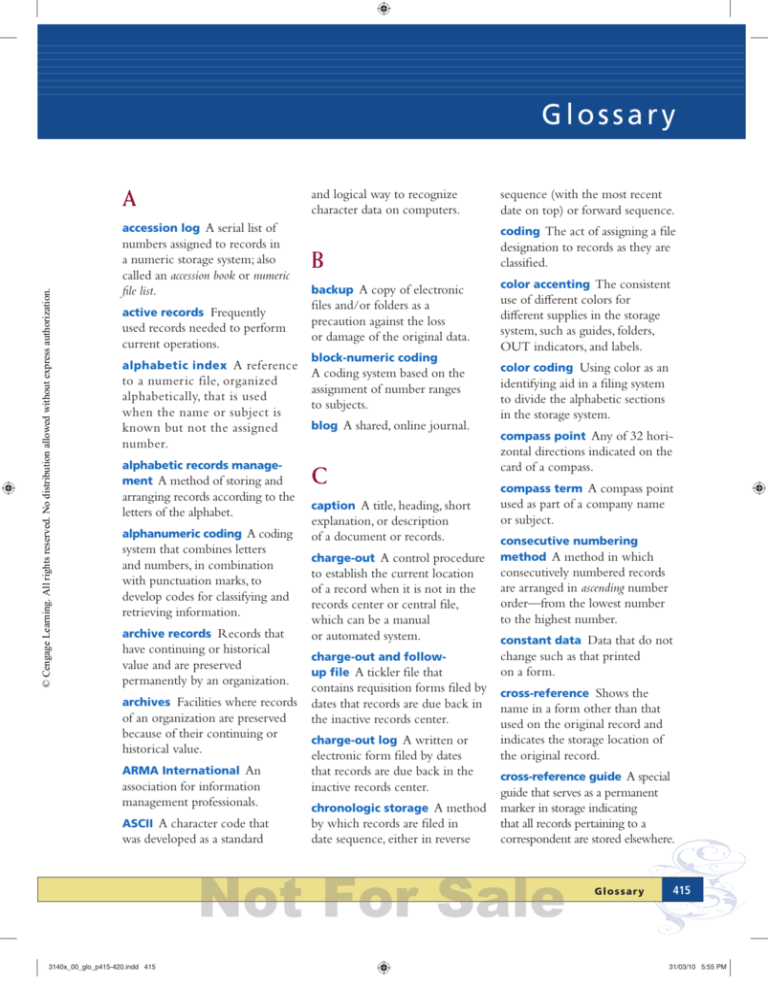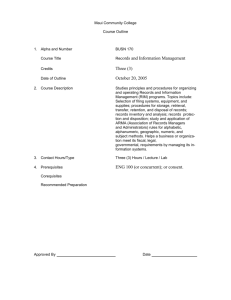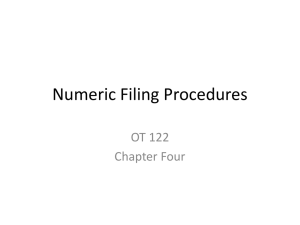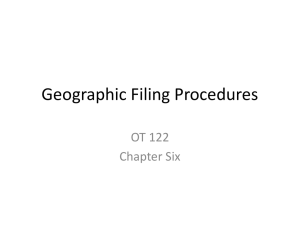
G lo s s a r y
415
Glossary
A
and logical way to recognize
character data on computers.
sequence (with the most recent
date on top) or forward sequence.
B
coding The act of assigning a file
designation to records as they are
classified.
© Cengage Learning. All rights reserved. No distribution allowed without express authorization.
accession log A serial list of
numbers assigned to records in
a numeric storage system; also
called an accession book or numeric
file list.
active records Frequently
used records needed to perform
current operations.
alphabetic index A reference
to a numeric file, organized
alphabetically, that is used
when the name or subject is
known but not the assigned
number.
backup A copy of electronic
files and/or folders as a
precaution against the loss
or damage of the original data.
block-numeric coding
A coding system based on the
assignment of number ranges
to subjects.
blog A shared, online journal.
alphabetic records management A method of storing and
C
arranging records according to the
letters of the alphabet.
caption A title, heading, short
alphanumeric coding A coding
system that combines letters
and numbers, in combination
with punctuation marks, to
develop codes for classifying and
retrieving information.
archive records Records that
have continuing or historical
value and are preserved
permanently by an organization.
archives Facilities where records
of an organization are preserved
because of their continuing or
historical value.
ARMA International An
association for information
management professionals.
ASCII A character code that
was developed as a standard
explanation, or description
of a document or records.
color accenting The consistent
use of different colors for
different supplies in the storage
system, such as guides, folders,
OUT indicators, and labels.
color coding Using color as an
identifying aid in a filing system
to divide the alphabetic sections
in the storage system.
compass point Any of 32 hori-
zontal directions indicated on the
card of a compass.
compass term A compass point
used as part of a company name
or subject.
consecutive numbering
method A method in which
charge-out A control procedure
to establish the current location
of a record when it is not in the
records center or central file,
which can be a manual
or automated system.
consecutively numbered records
are arranged in ascending number
order—from the lowest number
to the highest number.
charge-out and followup file A tickler file that
change such as that printed
on a form.
contains requisition forms filed by
dates that records are due back in
the inactive records center.
cross-reference Shows the
charge-out log A written or
electronic form filed by dates
that records are due back in the
inactive records center.
chronologic storage A method
by which records are filed in
date sequence, either in reverse
constant data Data that do not
name in a form other than that
used on the original record and
indicates the storage location of
the original record.
cross-reference guide A special
guide that serves as a permanent
marker in storage indicating
that all records pertaining to a
correspondent are stored elsewhere.
Not For Sale
3140x_00_glo_p415-420.indd 415
Glo s s a r y
415
31/03/10 5:55 PM
Glossary
Not For Sale
cross-reference sheet A sheet
placed in an alternate location
in the file that directs the filer
to a specific record stored in
a different location other than
where the filer is searching.
D
data warehouse A collec-
tion of data designed to support
management decision-making.
database A collection of related
data stored on a computer system.
decimal-numeric coding
A numeric method where
records are classified by subject
in units of ten and coded for
arrangement in numeric order.
first referring to an index or
a list of names for location in
the files.
into a numeric code that is only
understood by the intended
recipient of the information.
disaster recovery plan A plan
developed and implemented to
provide guidance for protecting
records and information and
continuing business operations
when emergencies and
disasters occur.
encyclopedic arrangement
(subject) A subject filing
document imaging An
automated system for scanning,
storing, retrieving, and managing
images of physical records in an
electronic format.
arrangement in which records are
filed under the specific subtitle to
which they relate.
encyclopedic arrangement
The alphabetic arrangement
of major geographic divisions
plus one or more geographic
subdivisions also arranged in
alphabetic order.
duplex-numeric coding
enterprise content
management (ECM) The
A coding system using numbers
(or sometimes letters) with two
or more parts separated by a dash,
space, or comma.
technologies, tools, and methods
used to capture, manage, store,
preserve, and deliver content
across an enterprise.
density The degree of optical
opacity of material that determines
the amount of light that will pass
through it or reflect from it.
E
destruction date file A tickler
e-commerce An electronic
file containing copies of forms
completed when records are
received in a records center.
method to communicate and to
transact business over networks
and through computers.
F
destruction file A file that
electronic data interchange
(EDI) A communication
characters treated as a unit
of information.
procedure between two
companies that allows the
exchange of standardized
documents through computers.
filename A unique name given
electronic fund transfer
(EFT) Electronic payments and
filing method The way in
contains information on the
actual destruction of inactive
records.
destruction notice
A notification of the scheduled
destruction of records.
destruction suspension
A hold placed on the scheduled
destruction of records.
dictionary arrangement
A single alphabetic filing
arrangement in which all types
of entries (names, subjects,
titles, etc.) are interfiled in
alphabetic order.
direct access A method of
accessing records by going
directly to the file without
3140x_00_glo_p415-420.indd 416
external record A record
collections.
electronic mail A system
created for use outside an
organization.
field A set of one or more
to a file stored for computer use
that must follow the computer’s
operating system rules.
which records are stored in a
container such as a filing cabinet
or a folder on a hard disk or
removable storage device.
that enables users to compose,
transmit, receive, and manage
electronic documents and images
across networks.
filing segment The name by
electronic record Data stored
firewall A combination
on electronic media that can be
readily accessed or changed.
encryption The process of
converting meaningful information
© Cengage Learning. All rights reserved. No distribution allowed without express authorization.
416
which a record is stored and
requested.
hardware and software buffer
that many organizations place
between their internal network
and the Internet to protect
31/03/10 5:55 PM
G lo s s a r y
the internal network from
outside intrusion.
geographic records
management A method of
flash drive A read/write
storing and retrieving records
by location using a geographic
filing system.
external storage device that
attaches to a computer via a
USB port and consists of a small
printed circuit board encased in a
hard plastic covering.
© Cengage Learning. All rights reserved. No distribution allowed without express authorization.
folder or directory A subdivision
guide A rigid divider used to
identify a section in a file and to
facilitate reference to a particular
record location.
of storage space created by the
operating system of a computer.
follower block (compressor)
A device at the back of a file
drawer that can be moved to
allow contraction or expansion of
the drawer contents.
follow-up A system for assuring
I
image record A digital or
photographic representation of
a record on any medium such as
microfilm or optical disk.
important record A record
form A physical or electronic
document with a fixed arrangement of predetermined spaces
designed for entering and
extracting prescribed information or variable data.
inactive records Records that
that assists in performing
business operations and is usually
replaceable but at great cost.
do not have to be readily available
but which must be kept for legal,
fiscal, or historical purposes.
inactive records index An
general folder A folder
for records to and from
correspondents with a small
volume of records that does not
require an individual folder.
geographic filing
system The classification of
records by geographic location
usually arranged by numeric code
or in alphabetic order.
geographic information
system A computer system
designed to allow users to
collect, manage, and analyze large
volumes of data referenced to a
geographic location by some type
of geographic coordinates such as
longitude and latitude.
indexing units The various
words that make up the filing
segment.
indirect access A method of
access to records that requires
prior use of an external index.
individual folder A folder used
to store the records of an individual
correspondent with enough
records to warrant a separate folder.
inspecting Checking a
the timely and proper return of
materials charged out from a file.
G
417
index of all records in the inactive
records storage center.
index A systematic guide that
allows access to specific items
contained within a larger body
of information.
indexing The mental process of
determining the filing segment
(or name) by which a record is
to be stored and the placing or
listing of items in an order that
follows a particular system.
indexing order The order in
which units of the filing segment
are considered.
indexing rules Written
record to determine whether it is
ready to be filed.
internal record A record that
contains information needed to
operate an organization.
Internet A worldwide network
of computers that allows public
access to send, store, and receive
electronic information over
public networks.
Internet forum An online
place where people can post
and read messages; also called
a message board.
ISO 15489 A standard for
records management policies and
procedures.
K
key unit The first unit of a filing
segment.
knowledge management An
interdisciplinary field concerned
with systematic, effective
management and utilization of an
organization’s knowledge resources.
L
label A device that contains the
name, subject, or number assigned
to the file folder or section
contents.
Not For Sale
3140x_00_glo_p415-420.indd 417
procedures that describe how
filing segments are ordered.
31/03/10 5:55 PM
Glossary
Not For Sale
leading zeros Zeros keyed
metadata Data about data, such
at the beginning of a number
so that all numbers in a group are
the same number of digits.
An arrangement of geographic
records with primary guides
labeled with alphabetic letters.
as that which describes how, when,
and by whom a particular set of
office of record An office
data was collected and formatted.
designated to maintain the record
or official copy of a particular
microform The collective
record.
term for all microimages such as
microfilm, microfiche, aperture card, official record A significant,
microfilm jacket, or microfilm roll.
vital, or important record of
location name guide plan
micrographics The technology
An arrangement of geographic
records with primary guides
labeled with location names.
by which recorded information can
be reduced to a microform, stored,
and retrieved for reference and use.
continuing value to be protected,
managed, and retained according
to established retention
schedules.
middle-digit storage
on-call/wanted form A written
A numeric storage method in
which the middle digits are
used as the primary division for
organizing the filing system.
request for a record that is out of
the file.
lettered guide plan
M
magnetic media A variety of
magnetically coated materials
used for computers for data
storage; e.g., hard disk, magnetic
tape, redundant array of
independent disks (RAID),
videotape.
migration The process of
moving data from one electronic
system to another, usually in
upgrading hardware and software,
without having to undergo a major
conversion or reinputting data.
magnification ratio The
relationship between the size of
an image and the original record
when viewed on a microfilm
reader screen.
management The process
of using an organization’s
resources to achieve specific
goals through the functions of
planning, organizing, leading, and
controlling.
master index A printed
alphabetic listing in file order of all
subjects used as subject titles in the
filing system.
media compatibility How
well the media and the equipment
needed to access information stored
on the media work together.
N
name index A listing of
correspondents’ names stored in a
subject file.
nonconsecutive numbering
A system of numbers that has
blocks of numbers omitted.
nonessential record A record
that has no predictable value after
its initial use.
nonrecord An item that is not
usually included within the scope
of official records such as a day
file, reference materials, and drafts.
one-period transfer method
A method of transferring records
from active storage at the end of
one period of time, usually once
or twice a year, to inactive storage.
operating system An organized
collection of software that
controls the overall operations of
a computer.
optical character recognition
(OCR) Machine-reading
of printed or written characters
through the use of light-sensitive
materials or devices.
optical media A high-density
information storage medium
where digitally encoded
information is both written
and read by means of a laser.
OUT indicator A control
device, such as a guide, sheet, or
folder, that shows the location of
borrowed records.
numeric index A current list of
all files by the file numbers.
media stability The time the
numeric records management
media will maintain its original
quality so that it can continue to
be used.
Any classification system for
arranging records that is based
on numbers.
3140x_00_glo_p415-420.indd 418
O
© Cengage Learning. All rights reserved. No distribution allowed without express authorization.
418
P
path A notation that includes
the drive, the folder, and filename
where a file is stored.
31/03/10 5:55 PM
G lo s s a r y
incorporates the use of an
electromagnetic or electrostatic
radio frequency to identify an
object, animal, or person.
records disposition The final
RAID (redundant array
of independent disks)
records inventory A detailed
perpetual transfer method
A method of transferring records
continuously from active to inactive
storage areas whenever they are no
longer needed for reference.
A computer storage system
containing many hard disk drives
that send data to a computer over
parallel paths.
listing that could include the
types, locations, dates, volume,
equipment, classification
systems, and usage dates of an
organization’s records.
personal digital assistant
(PDA) A small handheld
record Stored information made
records management The
or received by an organization
that is evidence of its operations
and has value requiring its
retention for a specific period
of time.
systematic control of all records
from their creation or receipt,
through their processing, distribution, organization, storage, and
retrieval, to their ultimate
disposition.
periodic transfer method
A method of transferring active
records at the end of a stated
period of time—usually
one year—to inactive storage.
© Cengage Learning. All rights reserved. No distribution allowed without express authorization.
419
computer that can share data with
other computers.
pick list A list containing
specific records needed for a
given program or project.
podcast A broadcast sent over
the Internet to receivers who
hear and/or view the information
via computers, MP3 players, or
other electronic devices.
position The location of the tab
across the top or down one side
of a guide or folder.
primary guide A divider that
identifies a main division or section
of a file and always precedes all
other material in a section.
push technology Technology
that automatically delivers e-mail
and other data to a device based
on the user’s profile and request
for specific data.
Q
query A database object used
to instruct the program to find
specific information.
R
record (computer
record) A set of fields in a
database table that relate to one
person, object, or organization.
record and information life
cycle The life span of a record
destination of records after they
have reached the end of their
retention period.
records retention program
A program established and
maintained to provide retention
periods for records in an
organization.
as expressed in the five phases
records retention schedule
of creation, distribution, use,
A comprehensive list of records
maintenance, and final disposition. series titles, indicating for each the
record copy The official copy of length of time it is to be maintained.
a record that is retained for legal,
records series A group of
operational, or historical purposes. related records filed and used
together as a unit and evaluated as
records audit A periodic
a unit for retention purposes.
inspection to verify that an
operation is in compliance
records system A group of
with a records and information
interrelated resources acting
management program.
together according to a plan
to accomplish the goals of
records center A low-cost
the records and information
centralized area for housing and
management program.
servicing inactive records whose
reference rates do not warrant their records transfer The act of
retention in a prime office space.
changing the physical custody of
records center box A box
records with or without change
of legal title or moving them
from one storage area to another.
designed to hold approximately
one cubic foot of records, either
legal or letter size.
reduction ratio The relationship
records destruction The
disposal of records of no further
value beyond any possible
reconstruction.
between the dimensions of the
original or master and the
corresponding dimensions of the
photographed image.
Not For Sale
radio frequency identification
(RFID) A technology that
3140x_00_glo_p415-420.indd 419
31/03/10 5:55 PM
Glossary
Not For Sale
reference document Contains
special (auxiliary) guide
information needed to carry on
the operations of a firm over
long periods.
A divider used to lead the eye
quickly to a specific place in a file.
relative index A dictionary-
of records, according to a plan,
on a shelf or in a file drawer or
saving an electronic record.
tickler file A date-sequenced
file by which matters pending
are flagged for attention on the
proper date.
storage method A systematic
transaction document
way of storing records according
to an alphabetic, subject, numeric,
geographic, or chronologic plan.
A record used in an organization’s
day-to-day operations.
type listing of all possible words
and combinations of words by
which records may be requested.
release mark An agreed-upon
mark such as initials or a symbol
placed on a record to show that
the record is ready for storage.
requisition A written request
for a record or information from
a record.
resolution A measure of
the sharpness or fine detail of
an image.
retention period The time that
records must be kept according to
operational, legal, regulatory, and
fiscal requirements.
retrieval The process of
locating and removing a record
or file from storage or accessing
information from stored data on a
computer system.
S
SEE ALSO cross-reference
A notation on a folder tab or
cross-reference sheet that directs
the filer to multiple locations for
related information.
sorting Arranging records in
the sequence in which they are
to be stored.
special folder A folder that
follows a special guide in an
alphabetic arrangement.
3140x_00_glo_p415-420.indd 420
storage The placement
storing Placing records into
storage containers.
primary division under which
a record is filed and groups of
numbers are read from right to left.
tweet A short message posted
on the Twitter social network
website.
subject records management
An alphabetic system of storing
and retrieving records by their
subject or topic.
suspension (hanging)
folder A folder with built-in
hooks on each side that hang
from parallel metal rails on each
side of a file drawer or other
storage equipment.
synchronization The process
of bringing items into agreement,
such as updating the data on a
laptop computer to match the
data on a PDA.
T
tab A projection for a caption on
U
useful record A record that is
helpful in conducting business
operations and is usually
replaceable at slight cost.
V
variable data Data that change
each time a form is completed.
vital record A record that is
necessary for the continuing
operation of the organization and
is usually not replaceable.
W
a folder or guide that extends above
the regular height or beyond the
wiki A page or collection of web
regular width of the folder or guide. pages that allows people who access
it to contribute or modify content.
table A database object that
contains fields that hold data.
World Wide Web A part of the
terminal-digit storage
A numeric storage method in
which the last two or three digits
of each number are used as the
© Cengage Learning. All rights reserved. No distribution allowed without express authorization.
420
Internet that contains HTML
documents that can be displayed
and searched using web browser
programs.
31/03/10 5:55 PM











